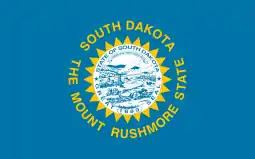William H. McMaster
William Henry McMaster (May 10, 1877 – September 14, 1968) was the tenth Governor of South Dakota, serving from 1921 until 1925, and also a United States Senator from that state. He was a member of the Republican Party.
William Henry McMaster | |
|---|---|
 | |
| United States Senator from South Dakota | |
| In office March 4, 1925 – March 3, 1931 | |
| Preceded by | Thomas Sterling |
| Succeeded by | William J. Bulow |
| 10th Governor of South Dakota | |
| In office January 4, 1921 – January 6, 1925 | |
| Lieutenant | Carl Gunderson |
| Preceded by | Peter Norbeck |
| Succeeded by | Carl Gunderson |
| 12th Lieutenant Governor of South Dakota | |
| In office January 2, 1917 – January 4, 1921 | |
| Governor | Peter Norbeck |
| Preceded by | Peter Norbeck |
| Succeeded by | Carl Gunderson |
| Member of the South Dakota Senate | |
| In office 1913–1916 | |
| Member of the South Dakota House of Representatives | |
| In office 1911–1912 | |
| Personal details | |
| Born | May 10, 1877 Ticonic, Iowa, U.S. |
| Died | September 14, 1968 (aged 91) Dixon, Illinois, U.S. |
| Political party | Republican |
| Spouse(s) | Harriet Russell |
| Alma mater | Beloit College |
| Profession | Banker |
Biography
McMaster was born to Samuel and Sara (Woodsum) McMaster in Ticonic, Iowa, Monona County, Iowa. His family moved to Sioux City, Iowa after the death of his father in 1880; and while growing up, he contributed to the family income by delivering the morning edition of the "Sioux City Journal." McMaster graduated from Sioux City High School and in 1899, he received a B.A. degree from Beloit College in Wisconsin.[1]
McMaster served as the head football coach at the University of Wisconsin–Oshkosh (then known as Oshkosh Normal School) in 1899.[2]
Career
In 1901, he moved to Yankton, South Dakota and worked as a cashier at that Security State Bank in Gayville, eventually becoming president of a banking chain in 1910.[3] He married Harriett Louise Russell and they had two children.[4]
McMaster served in the South Dakota House of Representatives in 1911 and 1912 in the South Dakota Senate from 1913 to 1916. He was Lieutenant Governor from 1917 through 1920.
Winning the nomination and the election McMaster became Governor of South Dakota from 1921 through 1924. As a friend of the farming community, he fought to revise taxes and provide state guaranteed credit as well as waging a successful battle against high gasoline prices.[5]
United States Senator from 1925 through 1931. Defeated in his bid for re-election, he became Vice President, then President and finally Chairman of the Board of Dixon National Bank in Illinois.[6]
Death
Aged 91 years, McMaster died in Yankton and was interred in Oakwood Cemetery, Dixon, Lee County, Illinois US.
Head coaching record
| Year | Team | Overall | Conference | Standing | Bowl/playoffs | ||||
|---|---|---|---|---|---|---|---|---|---|
| Oshkosh State Titans (Independent) (1899) | |||||||||
| 1899 | Oshkosh State | 1–6–1 | |||||||
| Oshkosh State: | 1–6–1 | ||||||||
| Total: | 1–6–1 | ||||||||
References
- "William H. McMaster". Biographical Directory of the United States Congress. Retrieved 18 October 2012.
- "Short Notes: W. H. McMaster". Oshkosh Daily Northwestern. October 4, 1899. Retrieved June 20, 2018.
- "William H. McMaster". National Governors Association. Retrieved 1 September 2012.
- "William H. McMaster". National Governors Association. Retrieved 1 September 2012.
- "William H. McMaster". National Governors Association. Retrieved 18 October 2012.
- "McMASTER, William Henry - Biographical Information".
External links
- United States Congress. "William H. McMaster (id: M000563)". Biographical Directory of the United States Congress.
- National Governors Association
- William H. McMaster at Find a Grave
| Party political offices | ||
|---|---|---|
| Preceded by Peter Norbeck |
Republican nominee for Governor of South Dakota 1920, 1922 |
Succeeded by Carl Gunderson |
| Preceded by Thomas Sterling |
Republican nominee for U.S. Senator from South Dakota (Class 2) 1924, 1930 |
Succeeded by John Chandler Gurney |
| Political offices | ||
| Preceded by Peter Norbeck |
Lieutenant Governor of South Dakota 1917–1921 |
Succeeded by Carl Gunderson |
| Preceded by Peter Norbeck |
Governor of South Dakota 1921–1925 |
Succeeded by Carl Gunderson |
| U.S. Senate | ||
| Preceded by Thomas Sterling |
United States Senator (Class 2) from South Dakota 1925–1931 |
Succeeded by William J. Bulow |

